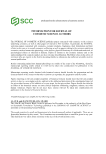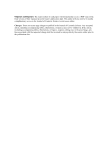319 Topical Apple Derivatives
RESULTS
TYPES OF PUBLICATIONS
A total of 14 publications were included in this systematic review that fit the inclusion
and exclusion criteria specified (Table II). The study designs of the publications were as
follows: 4 nonhuman experimental trials which included a randomized, placebo-control
trial over 28 days, 2 placebo-controlled experimental trials over 28 days, a randomized
placebo-controlled experimental study over 28 days, 9 human experimental trials (which
included double-blinded placebo-controlled human experimental studies) over 28 days, a
double-blind placebo-controlled human clinical trial over 120 days, a double-blind placebo-
controlled human clinical trial over 180 days, a positive and negative-controlled human
trial over 28 days (with no information on blinding), a placebo-controlled human clinical
study over 14 days (with no information on blinding), a placebo-controlled human clinical
study over 6 days (with no information on blinding), a double-blind placebo-controlled
human clinical trial over 365 days, a single-blinded placebo-controlled human clinical
study over 12 weeks, a double-blinded placebo-controlled human clinical study over 28
days, and 2 case reports. The maximum sample size was 43 male subjects of ages 27–58
years old. The length of study ranged between 4 hours to 365 days. 11 of the 15 studies
tested the apple derivative in combination with other ingredients, mainly composing a
vehicle for the derivative.
APPLE CAN REDUCE TRANSEPIDERMAL WATER LOSS
Three randomized controlled trials assessed the effects of apple fruit extracts in emulsifiers
on transepidermal water loss (TEWL) (Table II). One of the studies was a single-blinded,
randomized, controlled trial that evaluated the effectiveness of a topical cream containing
anthocyanin extract, an apple extract derivative, from the Malus domestica fruit (Table
II). A total of 12 human subjects of ages 25–35 years, without any skin diseases, were
involved in this study. The study included one treatment group and one control group: a
3% anthocyanin extract cream (water-in-oil emulsion with oil phase consisting of 12%–
24% paraffin oil, 2–3% Abil EM90, 3% bees wax oil phase, and water phase composed of
3% anthocyanin extract and 100% purified water) treatment group and 0% anthocyanin
extract cream (consisting of otherwise same formulation as treatment group) control
group.12 Each group was told to apply their respective creams to their cheeks daily over a
12-week period. Measurements of melanin, erythema, skin moisture content, TEWL, and
skin sebum content were taken on weeks 1, 2, 3, 4, 6, 10, and 12. Results revealed that
both the treatment group and control group displayed a significant decrease in TEWL
(p 0.05), however, there was no significant difference in TEWL between the two groups
(p 0.05).12 The treatment group also displayed a significant mean decrease in skin
melanin content (p 0.05) and skin erythema (p 0.05) compared to the placebo group.
There was a significant increase in skin moisture content and skin sebum in both the
treatment group and control group (p 0.05), however, there was no significant difference
in these changes between the two groups (p 0.05).
Another study was a double-blinded, randomized, controlled trial that investigated the
effectiveness of wild apple fruit extract on 10 female human participants (mean age of
26.18 ± 5.51 years), with moderately dry skin, and no history of dermatological diseases
(Table II).13 Each participant was told to apply a 6% wild apple fruit extract topical cream
RESULTS
TYPES OF PUBLICATIONS
A total of 14 publications were included in this systematic review that fit the inclusion
and exclusion criteria specified (Table II). The study designs of the publications were as
follows: 4 nonhuman experimental trials which included a randomized, placebo-control
trial over 28 days, 2 placebo-controlled experimental trials over 28 days, a randomized
placebo-controlled experimental study over 28 days, 9 human experimental trials (which
included double-blinded placebo-controlled human experimental studies) over 28 days, a
double-blind placebo-controlled human clinical trial over 120 days, a double-blind placebo-
controlled human clinical trial over 180 days, a positive and negative-controlled human
trial over 28 days (with no information on blinding), a placebo-controlled human clinical
study over 14 days (with no information on blinding), a placebo-controlled human clinical
study over 6 days (with no information on blinding), a double-blind placebo-controlled
human clinical trial over 365 days, a single-blinded placebo-controlled human clinical
study over 12 weeks, a double-blinded placebo-controlled human clinical study over 28
days, and 2 case reports. The maximum sample size was 43 male subjects of ages 27–58
years old. The length of study ranged between 4 hours to 365 days. 11 of the 15 studies
tested the apple derivative in combination with other ingredients, mainly composing a
vehicle for the derivative.
APPLE CAN REDUCE TRANSEPIDERMAL WATER LOSS
Three randomized controlled trials assessed the effects of apple fruit extracts in emulsifiers
on transepidermal water loss (TEWL) (Table II). One of the studies was a single-blinded,
randomized, controlled trial that evaluated the effectiveness of a topical cream containing
anthocyanin extract, an apple extract derivative, from the Malus domestica fruit (Table
II). A total of 12 human subjects of ages 25–35 years, without any skin diseases, were
involved in this study. The study included one treatment group and one control group: a
3% anthocyanin extract cream (water-in-oil emulsion with oil phase consisting of 12%–
24% paraffin oil, 2–3% Abil EM90, 3% bees wax oil phase, and water phase composed of
3% anthocyanin extract and 100% purified water) treatment group and 0% anthocyanin
extract cream (consisting of otherwise same formulation as treatment group) control
group.12 Each group was told to apply their respective creams to their cheeks daily over a
12-week period. Measurements of melanin, erythema, skin moisture content, TEWL, and
skin sebum content were taken on weeks 1, 2, 3, 4, 6, 10, and 12. Results revealed that
both the treatment group and control group displayed a significant decrease in TEWL
(p 0.05), however, there was no significant difference in TEWL between the two groups
(p 0.05).12 The treatment group also displayed a significant mean decrease in skin
melanin content (p 0.05) and skin erythema (p 0.05) compared to the placebo group.
There was a significant increase in skin moisture content and skin sebum in both the
treatment group and control group (p 0.05), however, there was no significant difference
in these changes between the two groups (p 0.05).
Another study was a double-blinded, randomized, controlled trial that investigated the
effectiveness of wild apple fruit extract on 10 female human participants (mean age of
26.18 ± 5.51 years), with moderately dry skin, and no history of dermatological diseases
(Table II).13 Each participant was told to apply a 6% wild apple fruit extract topical cream








































































